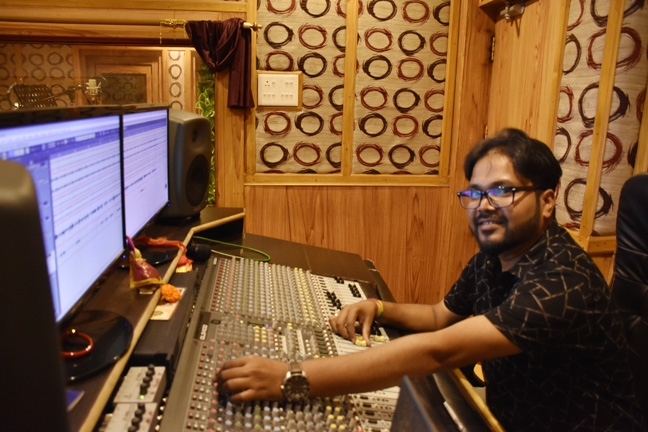Shaktiswar Mohapatra of Balasore always tries to get the perfect track. Working away from the limelight, he has recorded and mixed more than 3,000 popular Odia songs, elevating the audio experience for the listeners. He has finetuned the music for many popular Odia films like ‘Tiger’, ‘Sriman Surdas’, ‘Chauka Chhaka’, ‘Love Master’, ‘Sister Sridevi’, ‘Love Station’, ‘Sundergarh Ra Salman Khan’ and ‘Tu Tha Mu Jauchi Rushi’ among others.
“If you think mixing of music is an easy task then you are wrong,” says Shaktiswar, who has won many awards for his work. “After capturing the musical note of each instrument or the voice of the singer as clearly as possible, it is an audio engineer who works hard to make a song worth listening to. He balances the frequency and prepares the song to be played on a music player.”
Son of Malatilata and Amarnath Mohapatra, Shaktiswar completed a course in sound engineering course at the Biju Pattnaik Film and Television Institute, Cuttack, Odisha. He says, “I have been fascinated by music from my childhood. Realising my interest, my father admitted me to the Biju Pattnaik Institute. While pursuing the course, I learned a lot from my teachers Sri Nityashri Ranjan and Himanshu Khatua who perfected my skills.”
Shaktiswar, who has worked on the songs of more than 100 Odia films, says, “It’s an honour to work with popular music directors of the Odia film industry like Abhijit Majumdar, Goodly Rath, Shantiraj Khosla, Baidyanath Das and Sharat Nayak. I have worked with popular Odia singers like Ira Mohanty, Humane Sagar, Tapu Mishra, Asima Panda and Antara Chakraborty among others. Initially, I worked at Samrat Music’s recording studio where I learned the basics of music mixing. Although the going was good, a sharp decline in demand for Odia albums hit the music industry badly. But now times have changed. With unlimited access to the Internet, people watch and listen to songs on YouTube. Many people now are making songs on their own which helps the music industry to grow.”
About the digital recording process, he says, “I started my career when people used manual methods to mix songs. But now digital recording is common and has improved the quality of music. Sometimes we record songs in a hurry and it’s during the mixing that we spot flaws such as mismatch in rhythm and scale of music at the time of recording. These flaws, however, can easily be rectified digitally these days. There was a time when music directors had to go to Mumbai to record good songs. But now they can get the same quality in Odisha.”
About working in the Hindi film industry, Shaktiswar says, “Right from the start, I was not interested in moving to any place away from Odisha. Many of my classmates are working in Mumbai and have settled there. But the Odia music industry is growing steadily. Many artistes from Mumbai are coming down to Odisha to work here. This has vindicated my decision to stick to the Odia music industry.”
He continues, “Working in the film industry has always been challenging. You have to be creative as well as hardworking. While recording songs, I am surrounded by many people including the producer, director and actors of a movie. Knowing that my work is important for the success of a film pushes me to work better.”
Asked about the differences in recording songs for albums and films, Shaktiswar says, “I don’t see any differences as my focus remains only on the song. I have always tried to give my best to every song and this could be the reason that many artists of the state want to work with me.”
SOYONG, OP
